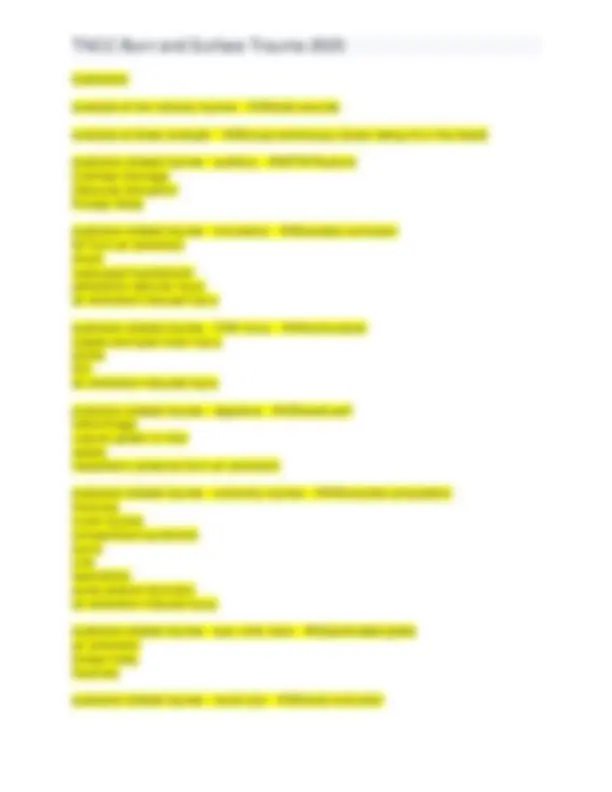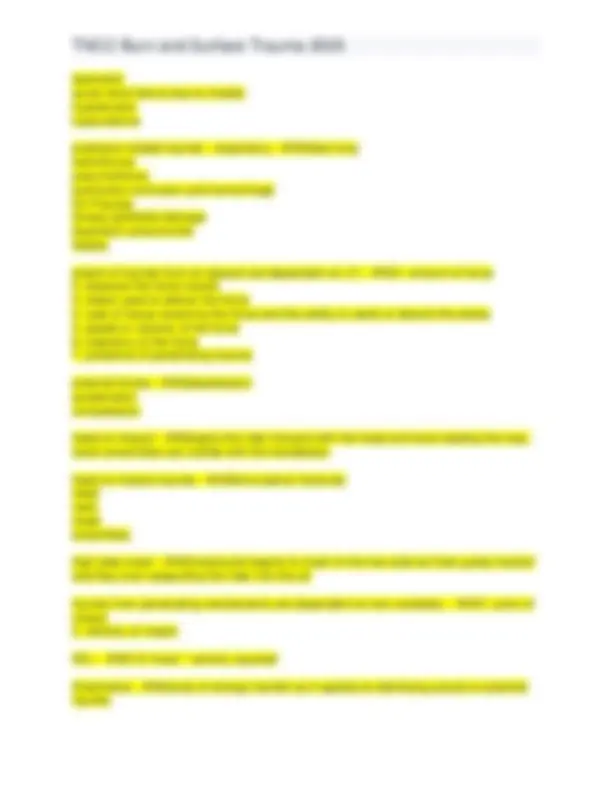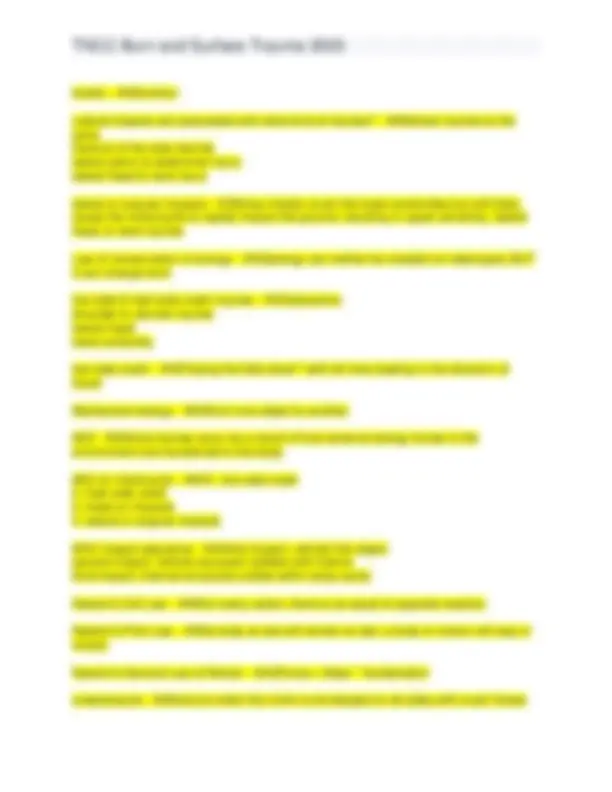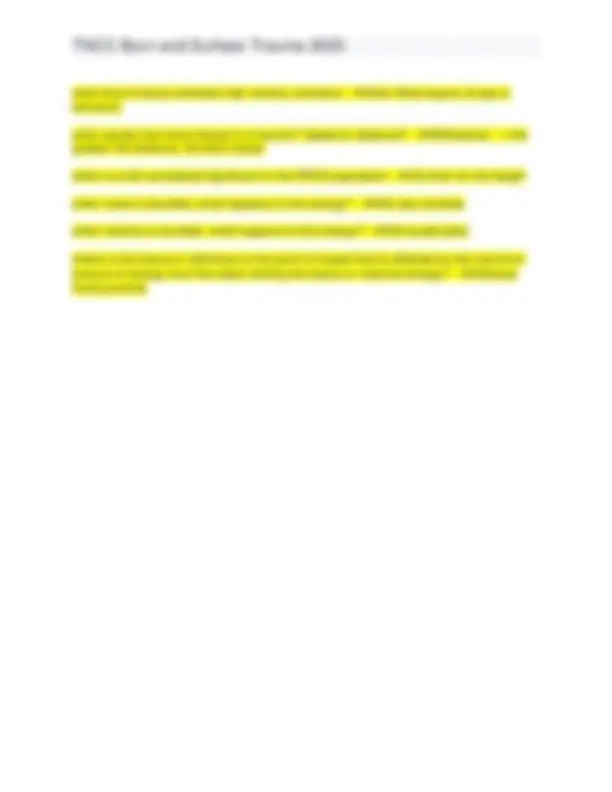






Study with the several resources on Docsity

Earn points by helping other students or get them with a premium plan


Prepare for your exams
Study with the several resources on Docsity

Earn points to download
Earn points by helping other students or get them with a premium plan
Community
Ask the community for help and clear up your study doubts
Discover the best universities in your country according to Docsity users
Free resources
Download our free guides on studying techniques, anxiety management strategies, and thesis advice from Docsity tutors
TNCC Burn and Surface Trauma 2025.pdf
Typology: Exams
1 / 8

This page cannot be seen from the preview
Don't miss anything!





Adult fluid replacement for ELECTRICAL burns - ANS4mL/kg Note that this is different from standard fluid replacement for burns (wt x 2mL x % TBSA) carbon monoxide poisoning - ANSCO replaces oxygen and hemoglobin creating carboxyhemoglobin s/s headache, confusion, nausea or vomiting half-life of CO is about one hour on 100% oxygen Treat with oxygen until carboxyhemoglobin levels drop to less than 10% (ABG) Frostbite treatment - ANSRewarm area over 15 to 30 minutes in controlled temperature water (98.6-102.2) Give pain medicine Avoid friction or rubbing Myoglobinuria Treatment - ANSSodium bicarb infusion to alkalize urine (promoting excretion of myoglobin) Prevent oliguria Normalize serum electrolytes Decompress any areas with compartment syndrome Pediatric or less than 40 kg burn fluid replacement formula - ANS3 mL/kg per % TBSA in addition infants and children weighing less than 30 kg should be placed on a glucose containing maintenance fluid, specifically D5 LR. "yaw" of a projectile - ANSability to move up and down acceleration forces - ANSsudden and rapid onset of motion ex: parked car hit by a high speed vehicle another form of mechanical energy with compression forces - ANShanging, strangulation, or compression asphyxia (chemical) Biomechanics - ANSgeneral study of forces and their effects on living tissue & the human body cavitation - ANSseparation of tissue resulting from a sound and/or hydraulic wave force can cause crushing/tearing/shearing forces Chemical energy - ANSheat energy transfer from active chemical substances such as chlorine, drain cleaner, acids, or plants
common mechanisms of blunt trauma - ANS1. Fall
laceration acute renal failure due to rhabdo hypotension hypovolemia explosive related injuries - respiratory - ANSblast lung hemothorax pneumothorax pulmonary contusion and hemorrhage AV Fistulas Airway epithelial damage Aspiration pneumonitis Sepsis extent of injuries from an assault are dependent on (7) - ANS1. amount of force
kinetic - ANSmotion Lateral impacts are associated with what kind of injuries? - ANSshear injuries to the aorta fracture of the side clavicle lateral pelvic & abdominal injury lateral head & neck injury lateral or angular impacts - ANSmay initially crush the lower extremities but will likely cause the motorcycle to rapidly impact the ground, resulting in upper extremity, lateral head, & neck injuries Law of conservation of energy - ANSenergy can neither be created nor destroyed, BUT it can change form low-side & high-side crash injuries - ANSabrasions shoulder & clavicle injuries lateral head lower extremity low-side crash - ANS"laying the bike down" witht eh tires leading in the direction of travel Mechanical energy - ANSfrom one object to another MOI - ANShow injuries occur as a result of how external energy forces in the environment are transferred to the body MOI on motorcycle - ANS1. low-side crash
tertiary blast injuries - ANSimpacts with larger objects propelled by the blast wind resulting in blunt trauma -- can result in pelvic or femur fractures or major thoracic injuries such as aortic & great vessel rupture the haddon matrix - ANSpre-event (host, agent, physical environment, socioeconomic environment) event (host, agent, physical environment, socioeconomic environment) post-event (host, agent, physical environment, socioeconomic environment) Thermal energy - ANStransfer of heat from the environment to the host to heavier objects require more or less force to more them? - ANSMORE True or false: Higher mass or greater speed results in greater energy - ANStrue two components of blast waves - ANSoverpressure dynamic pressure two primary injury patterns in frontal collision - ANS1. "up & over" the steering wheel or dashboard - head & chest lead the way (more likely with no seatbelt)
what kind of tissue tolerates high velocity cavitation - ANSair filled organs (lungs or stomach) what usually has more impact in a trauma? Speed or distance? - ANSDistance --> the greater the distance, the less impact when is a fall considered significant in the PEDS population - ANS>than 3x the height when mass is doubled, what happens to the energy? - ANSit also doubles when velocity is doubled, what happens to the energy? - ANSit quadruples where is the tissue in reference to the point of impact that is affected by the maximum amount of energy from the obect striking the tissue or maximal energy? - ANStissue most proximal